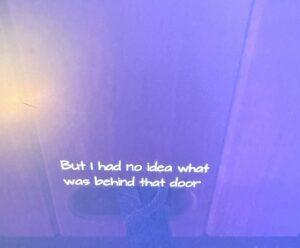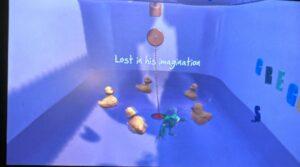For my critical play, I went through the walking simulator What Remains of Edith Finch, a video game developed by Giant Sparrow for ages 12+ and aimed toward people who enjoy a mystery genre. Before I get into my analysis, I want to say that What Remains of Edith Finch is the most enrapturing and impressive game that I have ever played. I was so enraptured in it that I did not feel the hours pass by as I played, and I would place my level of immersion above even that experienced when watching a movie. It has definitely become my new favorite game!
This brings me to the question: How does walking tell the story? I had never played a walking game before this critical play, so I was surprised by the fact that the environment of the video game was the main driver of the storytelling component. In the game, you start off on a boat as you make your way to the old house where your family used to live (you are Edith Finch). Once your character docks, the player has full freedom to explore anything around them. There is no clearly quantifiable “quest” or “goal,” instead the player must walk around and look around their physical environment (in the game) to discover objects and places that they can interact with in order to learn more about the character’s motivations and background, exploring an embedded narrative. At the same time as the player moves around in space, certain landmarks trigger a narrator that dictates part of the story. This narrator only gives small tidbits of information at a time, revealing minuscule components of a larger mystery that the player must work to gather more information about. This mechanic immediately drew me in as the game introduced a mystery regarding why Edith was exploring her family’s abandoned home and what happened to them. The format of the game was an embedded narrative, meaning that my role was not to change what was happening, but rather to discover the pre-defined narrative that the game creators present. I was drawn in more and more every time this storyline was added to gradually as I walked around and explored the building in the game (Edith’s old family home), creating an intriguing sense of mystery about why her family left in a rush, why everything was still in the home, who Edith was, and what happened to her missing family members. I became excited and extremely focused on finding new components of my environment that would trigger the narrator or that my character could interact with to reveal new information and understand more about what happened to Edith’s family. In many ways, it felt like I was piecing together a puzzle, not just by learning more about the game’s storyline, but by trying to figure out what parts of the environment I could/should interact with which added a feeling of challenge that also helped propel my gameplay forward. In doing so, I tried to look at as much of the environment as possible, trying to pay attention to small details that might help me create my own theories (outside of the guided game revelations) about what was happening (e.g. looking at the book titles, non-interactive items on tables, paintings, etc.). I found myself sometimes even ignoring interactive elements just to look at the environment in the game for longer because it was so life-like, detailed, and mysterious.


[examples of interactive elements of the game that allowed the player to discover new things about the story/setting]
Besides the aesthetic of sensation that was present through the game’s amazing graphics and enhanced by feedback from the game controller, throughout the game, three very clear aesthetics were created which were narrative, fantasy, and discovery. As the player walked around the game’s environment new parts of the game’s mystery/story were slowly revealed to build the world that we were immersed in more and more. Players were able to immerse themselves in the minds of different characters whenever they discovered their bedrooms, playing through their lives with a first-person perspective. The game made me feel like I was actually part of the story myself because I was free to interact and walk around my environment in the game. For example, I got to play as Molly, one of the child characters in the game, which allowed me to interact with parts of her room, read her diary, hear her thoughts, and learn about her experiences before her death. I got to do the same with every single character in the game which helped piece together the story of Edith’s family.

[example of a first-person perspective of one of the side characters in the game]
I also argue that it creates fellowship, not between different players, but between the players and the characters in the game. I felt myself becoming more and more invested in Edith’s desire to discover more about her family and everyone watching the game clearly built empathy for the characters in the game as we went through their stories. There were audible reactions to characters dying because we became invested in their stories. I felt that it was extremely clever for the creators of the game to allow players to jump into the minds of several different characters in the game because it provided a much more engaging and personal way of learning about them in comparison to reading a letter about them, just seeing pictures of them, etc. Playing as them made me empathize with their experiences and role in the game. One critique that I have, however, is that often when going into the perspective of a side character, the storytelling was accompanied by “mini-games” where a player was playing as an animal or cutting fish in addition to trying to explore an environment or walk through a story, which sometimes dragged on for too long and made me impatient in terms of getting back to the main storyline. I suspect that this was to add an extra challenge to maintain engagement, but I felt like they were sometimes a bit distracting or unnecessary.
Overall, I really loved this game!




